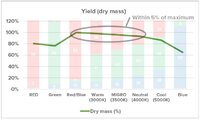Having spent a little time reading arround the subject, I came to the conclusion that plants can use a whole range of frequencies just with different efficiency. Sadly I haven't read anything that suggests algae is any different.


(research by migro on non aquatic plants)
Ppfd values are king the more light you have the faster plants and algae will grow.
I'm surprised that most the lights don't match the spectrum of the sun.The sun's has about 25% blue and a balance if green and red. That is about 5k colour temp.
I don't understand why we normally go for 6500k.
I think that colour spectrum does make a difference in plant shape but most of the commercial led lights available have a lot more blue light that will shorten stem length. ( not a bad thing) but I doubt there is enough of a difference between manufacturers to make any noticeable difference. The output power makes a far bigger difference
What is important is how the tank looks. Know one what's a pink full spectrum tank even if it gives great growth and saves them 10% on there electricity usage.
I would love to do some testing to see how low levels of uv light affect various algaes and plants. I'd need two identical tiny tanks and run one with a bank of uv leds. Then ask people to send me there algae covered plants.
Ideally set up a camera on time lapse. See if there is a level that kills the algae and not the plants.
Getting co2 and flow arround the tank also make a big difference. But it might be a useful weapon against algae.


(research by migro on non aquatic plants)
Ppfd values are king the more light you have the faster plants and algae will grow.
I'm surprised that most the lights don't match the spectrum of the sun.The sun's has about 25% blue and a balance if green and red. That is about 5k colour temp.
I don't understand why we normally go for 6500k.
I think that colour spectrum does make a difference in plant shape but most of the commercial led lights available have a lot more blue light that will shorten stem length. ( not a bad thing) but I doubt there is enough of a difference between manufacturers to make any noticeable difference. The output power makes a far bigger difference
What is important is how the tank looks. Know one what's a pink full spectrum tank even if it gives great growth and saves them 10% on there electricity usage.
I would love to do some testing to see how low levels of uv light affect various algaes and plants. I'd need two identical tiny tanks and run one with a bank of uv leds. Then ask people to send me there algae covered plants.
Ideally set up a camera on time lapse. See if there is a level that kills the algae and not the plants.
Getting co2 and flow arround the tank also make a big difference. But it might be a useful weapon against algae.





